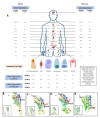Free Fatty Acid Receptors 2 and 3 as Microbial Metabolite Sensors to Shape Host Health: Pharmacophysiological View
- PMID: 32521775
- PMCID: PMC7344995
- DOI: 10.3390/biomedicines8060154
Free Fatty Acid Receptors 2 and 3 as Microbial Metabolite Sensors to Shape Host Health: Pharmacophysiological View
Abstract
The role of the gut microbiome in human health is becoming apparent. The major functional impact of the gut microbiome is transmitted through the microbial metabolites that are produced in the gut and interact with host cells either in the local gut environment or are absorbed into circulation to impact distant cells/organs. Short-chain fatty acids (SCFAs) are the major microbial metabolites that are produced in the gut through the fermentation of non-digestible fibers. SCFAs are known to function through various mechanisms, however, their signaling through free fatty acid receptors 2 and 3 (FFAR2/3; type of G-coupled protein receptors) is a new therapeutic approach. FFAR2/3 are widely expressed in diverse cell types in human and mice, and function as sensors of SCFAs to change several physiological and cellular functions. FFAR2/3 modulate neurological signaling, energy metabolism, intestinal cellular homeostasis, immune response, and hormone synthesis. FFAR2/3 function through Gi and/or Gq signaling, that is mediated through specific structural features of SCFAs-FFAR2/3 bindings and modulating specific signaling pathway. In this review, we discuss the wide-spread expression and structural homologies between human and mice FFAR2/3, and their role in different human health conditions. This information can unlock opportunities to weigh the potential of FFAR2/3 as a drug target to prevent human diseases.
Keywords: FFAR2; FFAR3; SCFA; gut; immune; microbiota.
Conflict of interest statement
The authors declare no conflict of interest.
Figures







Similar articles
-
Short-chain fatty acids: microbial metabolites that alleviate stress-induced brain-gut axis alterations.J Physiol. 2018 Oct;596(20):4923-4944. doi: 10.1113/JP276431. Epub 2018 Aug 28. J Physiol. 2018. PMID: 30066368 Free PMC article.
-
Short Chain Fatty Acids Enhance Expression and Activity of the Umami Taste Receptor in Enteroendocrine Cells via a Gαi/o Pathway.Front Nutr. 2020 Oct 29;7:568991. doi: 10.3389/fnut.2020.568991. eCollection 2020. Front Nutr. 2020. PMID: 33195366 Free PMC article.
-
The impact of short-chain fatty acids on GLP-1 and PYY secretion from the isolated perfused rat colon.Am J Physiol Gastrointest Liver Physiol. 2018 Jul 1;315(1):G53-G65. doi: 10.1152/ajpgi.00346.2017. Epub 2018 Mar 1. Am J Physiol Gastrointest Liver Physiol. 2018. PMID: 29494208
-
Short-Chain Fatty Acid and FFAR2 Activation - A New Option for Treating Infections?Front Cell Infect Microbiol. 2021 Dec 2;11:785833. doi: 10.3389/fcimb.2021.785833. eCollection 2021. Front Cell Infect Microbiol. 2021. PMID: 34926327 Free PMC article. Review.
-
Short-Chain Fatty Acid Receptors and Cardiovascular Function.Int J Mol Sci. 2022 Mar 18;23(6):3303. doi: 10.3390/ijms23063303. Int J Mol Sci. 2022. PMID: 35328722 Free PMC article. Review.
Cited by
-
Anti-Atherosclerotic Potential of Free Fatty Acid Receptor 4 (FFAR4).Biomedicines. 2021 Apr 24;9(5):467. doi: 10.3390/biomedicines9050467. Biomedicines. 2021. PMID: 33923318 Free PMC article. Review.
-
The maternal microbiome promotes placental development in mice.bioRxiv [Preprint]. 2023 Feb 15:2023.02.15.528712. doi: 10.1101/2023.02.15.528712. bioRxiv. 2023. Update in: Sci Adv. 2023 Oct 6;9(40):eadk1887. doi: 10.1126/sciadv.adk1887. PMID: 36824779 Free PMC article. Updated. Preprint.
-
The maternal microbiome promotes placental development in mice.Sci Adv. 2023 Oct 6;9(40):eadk1887. doi: 10.1126/sciadv.adk1887. Epub 2023 Oct 6. Sci Adv. 2023. PMID: 37801498 Free PMC article.
-
Gut peptides and the microbiome: focus on ghrelin.Curr Opin Endocrinol Diabetes Obes. 2021 Apr 1;28(2):243-252. doi: 10.1097/MED.0000000000000616. Curr Opin Endocrinol Diabetes Obes. 2021. PMID: 33481425 Free PMC article. Review.
-
Effect of ammonium fluoride as a mobile phase additive on quantitativity of fatty acids in electrospray ionization-liquid chromatography-tandem mass spectrometry.Anal Sci. 2025 Aug 18. doi: 10.1007/s44211-025-00832-7. Online ahead of print. Anal Sci. 2025. PMID: 40824612
References
-
- Nagpal R., Wang S., Ahmadi S., Hayes J., Gagliano J., Subashchandrabose S., Kitzman D.W., Becton T., Read R., Yadav H. Human-origin probiotic cocktail increases short-chain fatty acid production via modulation of mice and human gut microbiome. Sci. Rep. 2018;8:12649. doi: 10.1038/s41598-018-30114-4. - DOI - PMC - PubMed
-
- Nohr M.K., Pedersen M.H., Gille A., Egerod K.L., Engelstoft M.S., Husted A.S., Sichlau R.M., Grunddal K.V., Poulsen S.S., Han S., et al. GPR41/FFAR3 and GPR43/FFAR2 as cosensors for short-chain fatty acids in enteroendocrine cells vs FFAR3 in enteric neurons and FFAR2 in enteric leukocytes. Endocrinology. 2013;154:3552–3564. doi: 10.1210/en.2013-1142. - DOI - PubMed
-
- Samuel B.S., Shaito A., Motoike T., Rey F.E., Backhed F., Manchester J.K., Hammer R.E., Williams S.C., Crowley J., Yanagisawa M., et al. Effects of the gut microbiota on host adiposity are modulated by the short-chain fatty-acid binding G protein-coupled receptor, Gpr41. PNAS USA. 2008;105:16767–16772. doi: 10.1073/pnas.0808567105. - DOI - PMC - PubMed
-
- Trompette A., Gollwitzer E.S., Yadava K., Sichelstiel A.K., Sprenger N., Ngom-Bru C., Blanchard C., Junt T., Nicod L.P., Harris N.L., et al. Gut microbiota metabolism of dietary fiber influences allergic airway disease and hematopoiesis. Nat. Med. 2014;20:159–166. doi: 10.1038/nm.3444. - DOI - PubMed
Publication types
Grants and funding
LinkOut - more resources
Full Text Sources

